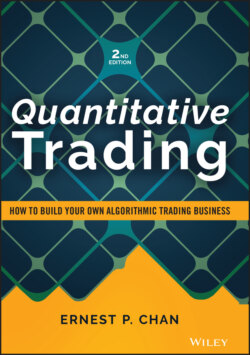Читать книгу Quantitative Trading - Ernest P. Chan - Страница 32
SUMMARY
ОглавлениеFinding prospective quantitative trading strategies is not difficult. There are:
Business school and other economic research websites.
Financial websites and blogs focusing on the retail investors.
Trader forums where you can exchange ideas with fellow traders.
Twitter!
After you have done a sufficient amount of Net surfing or scrolling through your Twitter feed, you will find a number of promising trading strategies. Whittle them down to just a handful, based on your personal circumstances and requirements, and by applying the screening criteria (more accurately described as healthy skepticism) that I listed earlier:
How much time do you have for babysitting your trading programs?
How good a programmer are you?
How much capital do you have?
Is your goal to earn steady monthly income or to strive for a large, long-term capital gain?
Even before doing an in-depth backtest of the strategy, you can quickly filter out some unsuitable strategies if they fail one or more of these tests:
Does it outperform a benchmark?
Does it have a high enough Sharpe ratio?
Does it have a small enough drawdown and short enough drawdown duration?
Does the backtest suffer from survivorship bias?
Does the strategy lose steam in recent years compared to its earlier years?
Does the strategy have its own “niche” that protects it from intense competition from large institutional money managers?
After making all these quick judgments, you are now ready to proceed to the next chapter, which is to rigorously backtest the strategy yourself to make sure that it does what it is advertised to do.
